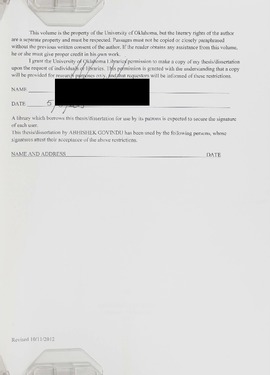| dc.contributor.advisor | Shah, Subhash | |
| dc.contributor.advisor | Ahmed, Ramadan | |
| dc.contributor.author | Govindu, Abhishek | |
| dc.date.accessioned | 2017-08-28T16:21:14Z | |
| dc.date.available | 2017-08-28T16:21:14Z | |
| dc.date.issued | 2015 | |
| dc.identifier.uri | https://hdl.handle.net/11244/51936 | |
| dc.description.abstract | Polymers such as xanthan and guar gum are widely used in the oilfield and food industry as viscosifiers. In hydraulic fracturing operation, guar gum polymer solution is used as fracturing fluid to create fracture in a target zone that contains hydrocarbon. Fracturing fluid viscosity helps transport propppant down the well and into the fracture. If the fluid is not viscous enough, the proppant is deposited at the mouth of the fracture and fracture closes. However, high concentration of polymer in the fluid leads to gel damage in the fracture and reduces its conductivity. | |
| dc.description.abstract | Poor fracture conductivity could lead to expensive re-fracturing operation or abandonment. One way to avoid gel damage/polymer residue problem is to use surfactant or surfactant based fluid. These fluids form micelles that are similar to polymer structure and, thereby, increase the viscosity. This micelle structure breaks down when it comes in contact with hydrocarbon. However, surfactant based fluids arc expensive and can form emulsion. The trend in the oil industry is to reduce the polymer content in the fracturing fluid and to crosslink it. Crosslinking is nece sary so as to increase the viscosity of the low polymer concentration linear gel. Despite these measures, gel damage to fracture conductivity is a concern and affects productivity or a well. | |
| dc.description.abstract | Blends of xanthan and guar gum are used in the food industry to prepare fluids that have superior viscosity then either parent polymer. This synergy between these polymers can be used to prepare new fracturing fluids that have desirable viscosity at low polymer concentration, thereby, solving the problem of proppant placement and fracture conductivity. In addition, prepared fluids would be cheaper than high concentration guar gum fluids as they require addition of less polymer. | |
| dc.description.abstract | In this study, the effect of polymer concentration, ratio of xanthan to guar polymer, and temperature on the synergy of xanthan and guar gum polymers is investigated. Particle settling behavior in these complex fluids under static conditions has been studied as well. Results show that increase in polymer concentration increases the strength of synergistic interaction while increase in temperature decreases it. Based on the results a 40 lbm/ Mgal guar gum/xanthan fluid blend was identified as a suitable fracturing fluid. This blend showed better viscosities at low shear rates than both 40 and 60 lbm/Mgal guar gum fluids. In addition, it is less expensive than 60 lbm/Mgal guar gum fluid. | |
| dc.format | xv, 124 leaves : illustrations ; 28 cm. | |
| dc.language | en_US | |
| dc.subject | Xanthan gum | |
| dc.subject | Guar | |
| dc.subject | Drilling muds -- Additives | |
| dc.subject | Polymers -- Rheology | |
| dc.subject | Hydraulic fracturing | |
| dc.title | Synergistic interactions of xanthan and guar gum polymers | |
| dc.type | Thesis | |
| dc.type | text | |
| dc.contributor.committeeMember | Pournik, Maysam | |
| dc.date.manuscript | 2015 | |
| dc.thesis.degree | Master of Science | |
| dc.note | Includes bibliographical references (leaves 101-108). | |
| ou.group | Mewbourne College of Earth and Energy::Mewbourne School of Petroleum and Geological Engineering | |
